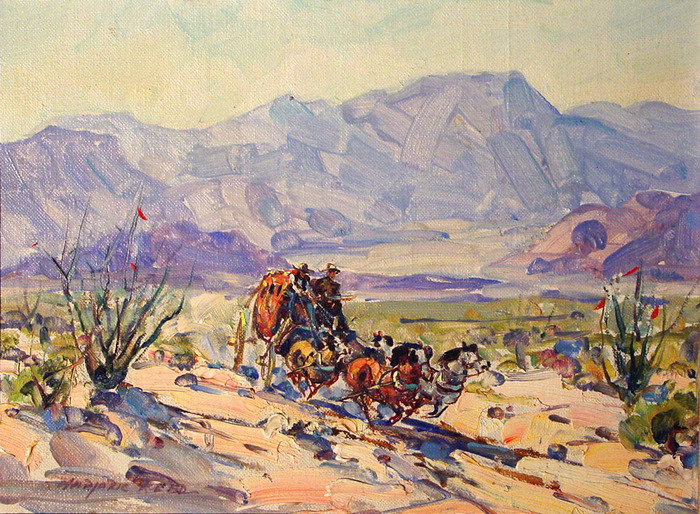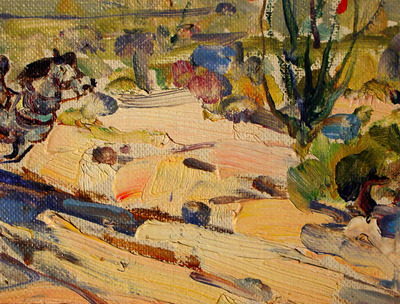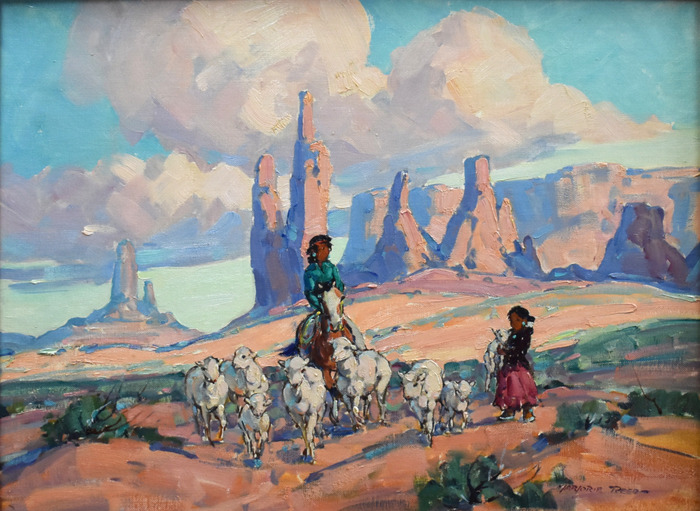Marjorie Reed a.k.a. Harvey Day Ocotillo In Bloom On The Butterfield Trail
-
- Marjorie Reed a.k.a. Harvey Day
- (1915-1996)
- California, Arizona Artist
- Image Size: 9 x 12
- Frame Size: 17 x 20
- Medium: Oil
- Ocotillo In Bloom On The Butterfield Trail
- Contact for Price & Info
- View All By This Artist
-
-
Biography
Marjorie Reed a.k.a. Harvey Day (1915-1996)
Marjorie Reed (Arizona / California Artist)
Marjorie Reed a.k.a. Harvey Day (1915-1996)
Born in Springfield, Illinois and raised in Los Angeles, Marjorie Reed gained a reputation for paintings of western scenes, particularly Butterfield Overland Stagecoaches and other scenes of cowboys, horses and figures associated with the Overland Mail Route. Sometimes she signed her paintings with men's names including Harvey Day and Fred Day. At age three, she began art lessons from her father, Walter Stephen Reed, a commercial artist, whom she later assisted in the designing of Christmas cards and with illustrations for the Mickey Mouse Beverage Company, affiliated with Walt Disney. In fact, she was so accomplished that shortly after, she was hired by Walt Disney Studios to do animation. But she did not like the regimentation of that work. In the mid-1930s, she studied at the Chouinard Art School and took lessons from Jack Wilkinson Smith, a renowned landscape painter who was a key artist in establishing the Biltmore Salon in Los Angeles. Knowing her love of the outdoors and horses, he encouraged her to roam the countryside. She became a friend of Captain William Banning who had been a stagecoach driver for his father Phineas Banning. She learned the romantic story of the Butterfield Overland Mail Stage, which, from 1857 to 1858, ran from San Francisco to the Yuma crossing on the Colorado River. In her Model-T Ford with her Alaskan Husky dog, she, based in Los Angeles from the late 1930s to late 1940s, traveled the stage-coach route and sketched for the paintings of her project to learn about and sketch various points along the route. Her travels included Palm Springs, which she visited many times after her first stop in 1937, and she also spent time in Julian, a California mountain town. Her "Butterfield Stage" series, about the 1858 Butterfield Overland Stage from St. Louis to San Francisco were completed in 1957 after years of travel and research, and a book titled The Colorful Overland Stage was published with twenty of her color reproductions and text by Richard Pourade. In 1967, she finished a second set of Overland Stage illustrations focused on Arizona. A third set was then devoted to New Mexico and Texas and a fourth set to Oklahoma, Arkansas and Missouri. In her later years, she and her fourth husband, Cecil Creese, a miner, became residents of Tombstone, Arizona in 1963 after living in northern California on the Placer River. According to her daughter, Judy Morris, Marjorie Reed died in 1997, living in the desert near the Butterfield Stage Station in California. Exhibition venues included the Biltmore Salon and Ebell Salon in Los Angeles, the Heard Museum in Phoenix, the Desert Inn Gallery in Palm Springs, and the Palm Desert Art Gallery in Palm Desert, and the Rosequist Gallery in Tucson, Arizona. Sources: Phil Kovinick and Marian Yoshiki-Kovinick, An Encyclopedia of Women Artists of the American West Peggy and Harold Samuels, The Illustrated Encyclopedia of Artists of the American West Edan Hughes, Artists in California 1760-1940 I met Marjorie in Tombstone, Arizona during the fall of 1987 at her small gallery. It was definitely a quaint old place which I believe was either a stagecoach or pony express stop- every bit the proper setting for her and a gallery for her paintings. Although I only met her a few times she definitely was a lovely old lady from the past. As I was currently stationed with the U.S. Army a few miles away, we talked of some of the places we both knew. The most favorite that she loved to talk about was her beloved Bedouins in Saudi Arabia. She called them 'her children". I believe she had been on a religious retreat or mission and spent quite some time with them. She felt that they and the Indians of the past that she knew were much the same. I had been stationed several times at Fort Huachuca, Arizona, which had been an old fort in 'Indian territory', so naturally I had become an history buff. So naturally that led to a discussion about some of her current paintings. One particular painting caught my eye. It depicted several members of an Indian family riding in a horse drawn wagon traveling through the snow to an old fireplace lit sod house. The painting is called Winter Eve at Kaibito Trading Post. I loved talking to that old lady and planned to again, but a few months later I was transferred to Germany. Although I had thought of her many times, especially as I gaze at her paintings, and wanted to see her, I never made it back to Tombstone, Arizona. Marjorie Reed is best known for her paintings of the stage stations and scenes along the Butterfield Overland Stage Route. Born in Springfield, Illinois in 1915, Reed’s family moved to southern California when she was twelve. Shortly afterwards, her father, Walter Reed, began working as a free-lance graphic artist for Mission Engraving and Offset, a commercial art firm in downtown Los Angeles. According to Ed Ainsworth in The Cowboy and Art, young Marjorie's "inner urge" was so strong she would sometimes walk up to eighteen miles just to sit on a corral fence and sketch the horses in action. The claim that she would walk so far simply to find her subject matter may seem somewhat dubious. However, it is known Reed possessed a strong will and was not afraid to travel long distances on foot to find her inspiration. In her early teens she would disappear for several days at a time in the San Gabriel Mountains to sketch deer and other wildlife. The excursions frequently took her from her home in Glendale deep into the Arroyo Seco, sometimes as far as Switzer Falls. Her only companion was Boy, a large Malamute. "I didn't need much to get by” Reed recounted many years afterwards, “Just a couple apples and a fig. Boy would catch his own food." Although the episodes caused her parents much worry and aggravation, this innate drive combined with her father’s tutelage helped Reed to hone her natural talent into a marketable commodity at a very young age. Reed started working alongside her father as a free-lance artist at Mission Graphics when she was fourteen, drawing and painting commercial work for several major companies including The Popsicle Company, Standard Oil, and Goodyear Tire and Rubber. During the summer between her junior and senior year in high school she designed a complete line of greeting cards for "one of the largest business concerns in the nation." After graduating from Glendale High School, she briefly attended Chouinard Art School but never finished. Her most important formal training came several years later, under the oversight of well-known California landscape artist Jack Wilkenson Smith. Starting in 1935, Reed initially walked the sixteen-mile round trip from her home in Highland Park to Smith's residence on Champion Place in Alhambra, also known as "Artists Alley". Shortly thereafter she began roller skating the distance to and from the lessons. Then a near death collision with an automobile prompted the Smith's to invite the young apprentice to live with them, and Reed became the youngest member of Artists Alley. The next two years provided a good education for reasons beyond Smith's tutelage. Artists Alley was a Western artist's Mecca at the time. Nearby residents included Clyde Forsythe, Eli Harvey, Norman Rockwell and Frank Tenney Johnson. Reed also credited Smith with encouraging her to roam the California countryside for inspiration. The two made countless sketching trips in the southern California foothills and canyons, frequently accompanied by well-known landscape artist Hanson Puthuff. During one of her trips, she came in contact with Captain William Banning. Banning had been a stagecoach driver for his father Phineas Banning, the owner of a Southern California shipping empire. Captivated by Banning’s knowledge of stagecoaches and horse teams, this event, along with her first visit to the Campbell Ranch near Vallecito, California, led Reed to embark on a project that would in time represent the pinnacle achievement of her artistic legacy. Reed first visited the Campbell Ranch in April of 1938 at the recommendation of John Hilton. Hilton believed the ranch's ambiance would provide a flavorful setting for her work. The ranch's owner, Everett Campbell, had recently finished heading up a complete restoration of the Vallecito Butterfield station. Reed recalled nearly fifty years later how impressed she was with Campbell’s handiwork, commenting that he was an artist in his own right. She also became intrigued with the history of the route and “what a colorful project” the Butterfield Overland Stage had been. Her short three day stay on the ranch, combined with her meeting with William Banning, helped to create Reed's lifelong artistic mission. Tracing the Butterfield Overland stage route through California, she created a series of thirty paintings, each one a representation of the various stage stations or other well-known locations along the route. For authenticity, and to help realistically capture the essence of the route, Reed camped out near many of the stage stations she painted. The series was finished in 1958 while Reed was living in Julian, California. Three years later, twenty of the thirty paintings were purchased by James S. Copley, owner and publisher of the San Diego Union Tribune. The success of the California collection led to a series of subsequent projects, portraying the Butterfield route from California eastward all the way to its origin in Tipton, Missouri. She completed a set of paintings for every state along the way: Arizona, New Mexico, Texas, Oklahoma, Arkansas and finally Missouri. The final canvas was finished in 1982, over forty years after her meeting with Banning and her first stay at the Campbell ranch had inspired her to begin the journey. Reed’s early start allowed her make her living as an artist for over sixty years. As a result, she left behind a very large body of work which consists primarily of Western themes. Although best known for her Butterfield paintings, her subject matter was known to range from burros (which she raised most of her later life) to conquistadors to cowboys on bucking broncs and Western landscapes. She also painted “quite a lot of canyon scenes” and thousands of paintings with Navajo themes. One of Reed's best-known series is a large collection of canvasses that she signed "Harvey Day". Reed claimed in a letter the year before her death that she used her husband’s name because at the time there was so much demand for her work that “perhaps I could get a little break from a too busy life”. She also stated that the paintings were created in the early 1940's, when Day had a job near the Grand Canyon. However, the Harvey Day paintings were actually created in the mid-1950's, several years after Harvey Day's death, as part of an arrangement with a Los Angeles importer/exporter who sold the paintings through a furniture store chain throughout the western United States. A different signature was used so there would be no conflict with any existing gallery obligations Reed had at the time. The steady cash flow provided by the agreement allowed her the resources to devote her time and energies towards the completion of her first California Butterfield series. Harvey Day was Reed's second husband and, according to those who knew her best, the great love of her life. Her first husband, Harry Lindgren, was regarded as Hollywood's premier sound engineer when the two married in 1939. The marriage produced two children: a daughter, Judy, in 1940 and a son, Steve, in 1944. However, by 1945 the two were divorced and Reed went from a large home in the Hollywood Hills to living in rustic shacks in the Southwestern deserts and mountains over the next several years. By 1946 she had hooked up with Day, an itinerant ranch hand who was in and out of prison numerous times for crimes ranging from forged checks to auto theft. He committed suicide in 1952 while an inmate at the Montana State Prison. In 1955 she married Lynn Molgard, Day's brother in law, and the two operated mink ranches in Colorado for the next year. After divorcing Molgard one year later she returned to Julian, California where she created both her Harvey Day and California Butterfield series over the next two years. Shortly thereafter she met her fourth husband, Cecil Creese. Reed's marriage to Creese lasted over twenty years, more than twice as long as her first three combined. Although he may not have been the great love of her life a la Harvey Day, he helped provide a stability that had been missing for most of her adult life. Creese was a prospector and mining engineer, and the pair lived in various areas throughout the West, including the Salmon River in northern California and Arivaca and Amado in southern Arizona. The union ended with his death in Tombstone, Arizona in 1978. In the early 1970’s Valley Bank in Arizona commissioned her to do a series of paintings on the Trading Posts of Arizona. Not long afterwards a private collector commissioned her to do a series of nine paintings with Hopi scenes in the Three Mesas area. In addition to the original Butterfield paintings, she did hundreds more of both Butterfield and other stage scenes. Reed claimed to have moved over eighty times in her life, spending most of her years in Arizona and Southern California. Her longest stay in one place was in the Tombstone area, where she owned and operated the Old Adobe Gallery in the 1980’s and early 90's. Located in an original 1880's adobe building, the gallery had no running water or electricity, but the ambiance provided the ideal setting for her work. The Old Adobe was open on weekends only. By now Reed's popularity was at its peak and frequently the gallery was sold out by early Saturday afternoon. She also provided free art lessons to local children on Sunday nights, which were held by candlelight while a mesquite fire roared in the fireplace. After her marriage to Cecil Creese, Reed converted to Catholicism and became deeply religious in nature. She once claimed in a letter that she “never painted anything. I just held the brush and God did the work.” She also felt her art was inspired partly as a result of the frustration she felt in being denied a ranching life. The pleasure experienced by those who enjoyed her work then alleviated this frustration, a frustration she claimed could only be alleviated “by returning the gift of the Creator.” After Cecil Creese's death Reed made eleven trips to Israel, which she always referred to as "The Holy Land", during the 1980's. Her last trip occurred in 1988, when she was deported by the Israeli government for encouraging peaceful protests by the Palestinians. Reed died while raking leaves the Friday after Thanksgiving in 1996 at the old Campbell Ranch in Vallecito. Not far from Vallecito is La Casa Del Zorro resort in Borrego Springs, where many of the original Butterfield California paintings purchased by the Copley family hung on permanent exhibit from 1970 until late 2007, when the resort was sold. The appeal endures to this day as the value of her work has steadily risen in the years since her death. Marjorie Reed a.k.a. Harvey Day was born in Springfield, Illinois in 1915. She was the daughter of a commercial artist. Raised in Los Angeles, she was the pupil of her father in designing Christmas Cards. At fourteen, she worked for Walt Disney. She studied at the Chouinard Art School and the Art Center School in Los Angeles, as well as with Jack Wilkinson Smith of Alhambra for two years. A series of twenty paintings of the 1858 Butterfield Overland Stage from St. Louis to San Francisco was incorporated into the book, "The Colorful Butterfield Overland Stage" by Richard F. Pourade. As to her pen or brush name, the following came from an authentication done by the artist, herself. "Dear Terry, please excuse the delay in answering your interesting note of September 14. Yes, that is an older painting of mine, Harvey Day was my deceased husband as there was such a demand of my depression priced paintings, I decided to use his name and perhaps I could get a little relief from a too busy life. Incidentally I have always known that God painted all the paintings I just held the brush' The particular painting was done in the early 40's. I had lived for a few years at the Grand Canyon. My husband had a job in the area., so I painted quite a few canyon scenes. As I have never changed my price you can imagine how very long I am with orders. Thanks for your kind interest in God's and my work. Most sincerely, Marjorie Reed."




